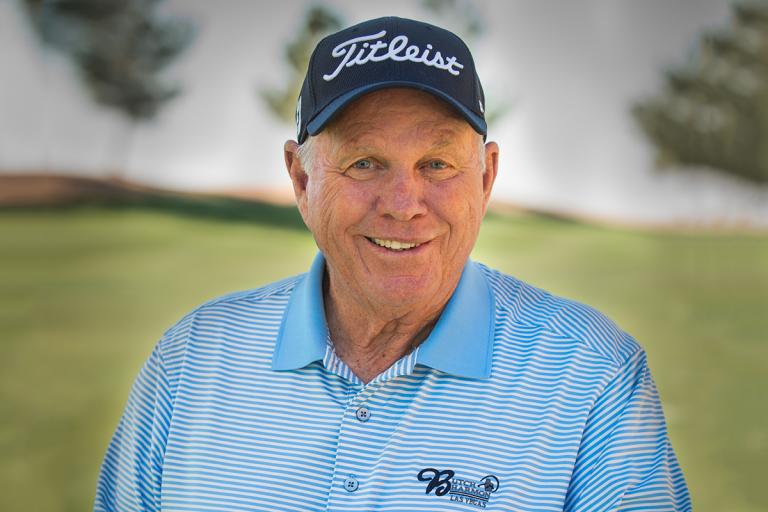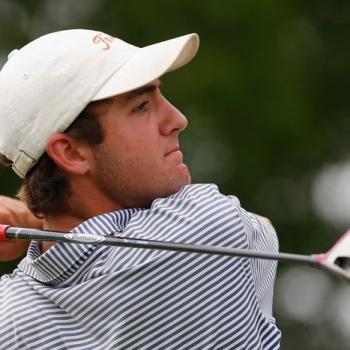I regard Butch Harmon, whom I’ve known a very long time, to be the best swing coach on the PGA Tour, thus pretty much in the world. Butch used to be the swing instructor of Greg Norman and Tiger Woods. If Tiger would have never left Butch in a huff, I think Tiger would have surpassed Jack Nicklaus’ #1 record of 18 majors that he won. Tiger lost his swing for several years. But the Tiger has now regained his swing, and he won the Masters last year to get to 15 majors. The big question in golf is can Tiger catch Jack’s 18 majors?
Yesterday, Golf online published an article involving an interview with Butch Harmon about whether or not it is better to swing the golf club with a closed clubface in the backswing or an open clubface. Butch gave swing tips that included answering this.
A good reason for asking Butch that question is that he is the swing coach/instructor for three of the best pros on the PGA Tour and thus in the world now–Brooks Koepka, Dustin Johnson, and John Rahm. All three of them swing with a very noticeable closed clubface on the backswing. The best way to tell this is to watch their clubface at the top of their backswing. A closed clubface results in the clubface (more noticeable on long irons or the driver) aims up at the sky. When you do that, you have to open the clubface on the downswing and follow through in order to keep the ball from starting left of your target and then hooking to the left. It’s called a closed-to-open swing. Swinging with an open clubface on the backswing results in the clubhead at the top of the backswing hanging almost straight down at the ground. It is easier to tell either clubface position at the top of the backswing with a still picture or at least slow motion.
In my day, the two best players who swung the golf club closed-to-open were Arnold Palmer and Lee Trevino. One time I was playing with Arnie in a PGA Tour tournament at the famed Pinehurst No. 2 course. I’ve blogged about this before. Walking up the 18th fairway, I asked Arnie why he swings closed-to-open. He was not offended in the least at my question, as I thought a player could be. He said, “When I was young, I learned that I could drive the ball straighter by swinging that way.” I believe Arnold was the straightest driver of the ball in my day who still hit the ball a long distance. It was generally thought that players who swung the club closed-to-open could not hit high shots well or at least hit high long iron shots, and their wedge game was not as good. For such a great player as Arnold Palmer, I believe that was true of him. And Lee Trevino, he practically hit the ball underground he hit it so low, having groomed his game where the wind blows so much the birds can’t fly–El Paso, Texas.
I was sitting in the lunch room at the 1970 U.S. Open at Hazeltine, Minnesota, that Tony Jacklin won. Dan Sikes was discussing with us a photo on the front cover of Golf Digest magazine that was Jack Nicklaus’ swing at the top of his backswing. The caption said, “Does this man swing square-to-square.” That was new language for swinging “closed-to-open.” The theme of that issue of Golf Digest was about a supposedly new way to swing the club. It wasn’t new at all, but a closed-to-open swing that was just dressed up with new language. The magazine was suggesting that maybe Jack Nicklaus really swings “square-to-square.” Dan Sikes was challenging that with us, and most of us were agreeing with him.
Jack Nicklaus then walked into the room. Dan held up the magazine, showing Jack his picture and said, “Jack, is this true, that you swing square-to-square.” Jack said, “what’s that?” Dan explained it and Jack said, “That and a dime will get you a cup of coffee.” In other words, there wasn’t any truth in it about his swing. In fact, in Jack’s later book, Golf My Way, I think it’s in that book that he explains about the clubface being closed, neutral, or open at the top. Jack therein says that neutral is best, open is second best, and closed is the worst. Jack Nicklaus swung a lot like Sam Snead, in which both at a big whole body turn on the backswing and lifted their left heel way off the ground at the top of the their backswing when swinging a driver.
I never saw anyone who could ever hit such high long iron shots at Jack Nicklaus. Like Sam, he could do that because he had a big turn and released the clubhead on the downswing a lot. The greatest shot I ever saw under the circumstances was on the 17th hole on Sunday on the Senior Tour at the Ford Players Championship at Dearborn, Michigan. I was playing with Jack in the last group, and he was two strokes behind Jesse Snead, who finished ahead of us as the leader. The 17th hole is a par five with a lake in front of a small green. Jack had 234 yards to the pin, which was tucked somewhat on the front, near the water. He hit his one iron (Lee Trevino used to say that only God and Jack Nicklaus can hit a one iron) way up in the air, right at the pin. As I remember the ball hit on the front portion of the firm green and would up about ten feet or more from the pin. I don’t think Jack made that putt. But he left his 30+ foot birdie on the front lip of cup on the 18th hole to lose to Jesse by one stroke. That one iron shot on 17th, of all the players in the field, is a shot that only Jack Nicklaus would try. But then, like the Supermex, most of the players didn’t even have a one iron.
Butch Harmon’s #2 tip of the six is, “A clubface too closed is better than too open.” Butch explains, “If you had to error, I’d rather see someone shut at the top then [sic.] wide open, because if you’re shut at the top and have any strength at all, you can hold [the clubface] off as you go through, or you can let it release if you want to hit a draw. If it’s wide open at the top, you need to do a lot of catching up with your hands and it disrupts the timing of the golf swing.”
Butch Harmon is the son of Claude Harmon, who was a renown golf swing instructor, head pro at the famed Winged Foot where the U.S. Open will be played this year. Claude Harmon’s also won the Masters in 1948 by five strokes. As I recall, Claude Harmon was known for teaching a somewhat closed clubface in the backswing even though he was a friend of Ben Hogan.
Last week, in this same publication, Golf online, they published an interview of my friend Bob Toski, a former PGA Tour player who used to be more renown as a swing instructor than Butch Harmon was, but then there is an age difference there. Bob was quoted as saying that Ben Hogan–the greatest ball striker ever and winner of nine majors, thus tied for third place behind Jack Nicklaus and Tiger Woods in that category and considered to have understood the golf swing better than anybody ever did–said he never saw a really good player who swung closed-to-open or something like that.
Hogan was always tight-lipped about the golf swing except when he wrote a book about it. Frank Stranahan, heir of Champion spark plugs, outstanding amateur, and then a pro on the PGA Tour, once asked Ben Hogan for golf lessons, telling him he could write any figure on the check he wanted to. Ben reportedly said, “Son, do you have a shag bag?” In those days, we didn’t have all these golf balls at driving ranges, so you had to bring your own balls in a shag bag in order to practice. Frank answered, “Yes sir.” Ben then said, “Go use it.” That was Hogan. His attitude was that he had to learn how to “dig it out of the dirt,” as he called it, so everybody else should too.
In Hogan’s main book, Five Lessons: The Modern Fundamentals of Golf, he explains how he discovered something in the golf swing that led to his success more than anything else. He called it “supination.” Ben Hogan was only 5′, 8″ tall, yet early in his career he hit the ball very far for his size. To do so, he swung the club way, way, past parallel at the top of his backswing. But he had trouble with some big hooked drives. He did two things to correct this and became known as a slight fader of the ball, something that hardly no pro did in Hogan’s day. That is how many of the best PGA Tour players play the game nowadays. Hogan was way ahead of his time in so many ways about his swing. Another was that he restricted his lower body movement on his backswing, so that he kept his left heel planted on the ground or he barely let daylight show.
But in Five Lessons, supination was what came to be called “the Hogan secret.” He explained that when he drew the clubhead back early in his backswing, he cupped his left wrist very noticeably. The result was that his clubface did what pros call “opening the clubface.” But he did it without fanning the clubface, and that was something you just never saw any Tour pro do. The result was that at the top of Hogan’s backswing, even though it was an extremely flat swing due to his short height and long arms, his clubface pointed up to the sky. Then in his downswing he purposely reduced that cupping formation in his left wrist so that at impact his hands were slightly ahead of his clubhead and his left wrist was a little bowed, just the opposite of being cupped. Then, on Hogan’s follow through, his clubhead did not pass his hands hardly at all, called “releasing the club.” That restriction of release is what made Ben Hogan so accurate.
These pros on Tour who swing closed-to-open, with the exception of Dustin Johnson, often have a similar upswing as Hogan did in that they prevent the clubhead of releasing much. Many of them punch their iron shots, resulting in a considerable divot and an abbreviated finish.
Butch Harmon is certainly right when he says there is more than one way to swing a golf club and be one of the best players ever. And while I respect Butch as perhaps the best of swing instructor, this is one place where I would differ with him and side with Hogan. I believe there have been more great players who played open-to-closed, thus with a big release on the follow through, than closed-to-open. The first I would name is Bobby Jones. The next is Sam Snead. When you look at still photos of their swings at the top of their backswings, their clubhead hung down at the ground. And in my day, the best players who also did that would include Lannie Watkins and Johnnie Miller. That’s why Sam Snead was so good at hitting a driver off the fairway and getting the ball up in the air as if it was a three-wood shot. The open clubface all0wed Sam, if fact, force Sam to release the clubhead a lot on his downswing. There was never a prettier golf swing in my day than that of Sam Snead, and Ernie Els has come the closest to it.
But I agree wholeheartedly with four of Butch’s other swing tips, such as (1) firm left wrist at impact, (2) teach the pupil and not a certain swing, (3) it’s all about repetition of the swing, and (4) make the game simple. Butch’s sixth and last tip is about how to correct that nemesis that many golfers experience at some time in their lives, and hopefully not always–the shank. If you want to trash on the golf course, “shank” is the best trash word in the book. Butch says, “Most shanks with a full swing are hit with a closed clubface.” Butch also blames the shank mostly swinging over the top. That definitely can do it.
For me, the first place you have to check when a golfer gets the shanks is his or her head position at address and then at impact. If your head is positioned more over your toes than it was at address, that likely is the reason you are shanking. The second place you check is how the player is starting his or her backswing. Shankers often close the clubface, like Butch says, but I think it is most often done by fanning the clubface plus closing it.
I got into the shanks once when I was a freshman in college. Talk about frustration! I discovered that I was doing the opposite of what Hogan taught about cupping the left wrist early in the backswing. Doing what Hogan says is what got me out of the shanks, and never had trouble with that again. In fact, I never shanked a ball in my entire professional golf career.












